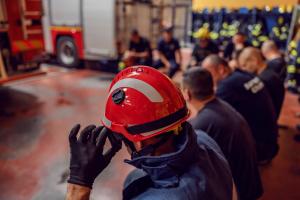
The LRT Gorizia framework improves disaster preparedness by institutionalizing community involvement through structured coordination mechanisms, pre-crisis training, and formal integration into municipal risk governance.
Map
Gorizia's Local Resilience Team
General Information
ISIG
Structured collaboration among stakeholders to enhance community resilience
Located in north-eastern Italy, Gorizia is a town of 34,350 inhabitants with a population density of 831.7 people per km².
Together with the neighbouring Slovenian communities of Nova Gorica and Šempeter-Vrtojba, it forms a unique cross-border area marked by close cooperation and shared territorial challenges.
LRT Gorizia was established so to addressed gaps in local resilience planning, including limited community participation in disaster preparedness, lack of structured frameworks for integrating community insights, and challenges in sustaining long-term engagement, locally but also within a cross-border perspective.
Needs Addressed
LRT Gorizia was established to address specific key gaps in local and cross-border resilience planning, including:
- Lack of structured frameworks to integrate community insights into emergency response, reducing the effectiveness of institutional crisis management.
Challenges in sustaining long-term engagement of local actors, making it difficult to maintain preparedness beyond immediate crisis events.
Cross-border coordination barriers, where different regulatory frameworks, response protocols, and communication channels between neighbouring regions slow down emergency cooperation.
Lack of statistical data on resilience indicators, particularly regarding vulnerable group assessments (e.g., elderly, people with disabilities, migrant populations). The absence of standardized data collection and analysis tools makes it harder to develop targeted preparedness measures for at-risk communities.
The LRT framework ensures that marginalized communities have access to preparedness training, information, and tailored crisis support mechanisms.
The LRT Gorizia focuses mainly on people with disabilities, elderly and migrant population.
Gorizia is characterised by a decentralised and multistakeholder governance setting. In this regard, the LRT is integrated into local emergency management structures, ensuring coordination with municipal authorities and civil protection agencies.
LRT fits within structured emergency response models, offering a pre-trained, organized, and scalable volunteer resource.
Infrastructure readiness level is considered medium to high.
- Low-resource environments: LRTs functions with minimal infrastructure, relying on local networks, community hubs, and decentralized coordination to support preparedness and response efforts.
- Developed emergency response settings: In areas with advanced infrastructure, LRTs act as a bridge between institutional response systems and community-based preparedness, enhancing coordination and response efficiency.
- Cross-border adaptability: Given the varying levels of emergency infrastructure across borders, the LRT model supports harmonization of response protocols, ensuring alignment between different national/regional emergency frameworks.
The LRT Gorizia model promoted continuous, multi-level engagement through structured interactions with citizens, CSOs, youth organizations, and civil protection actors.
To enable inclusive resilience planning by involving local communities in scenario co-design, risk perception assessments, training activities, and cross-border collaboration.
Long-term engagement through continuous training and structured preparedness programs.
The LRT framework focuses on long-term capacity-building, ensuring that volunteers:
- Continuously develop skills and knowledge relevant to disaster risk reduction and response.
- Are provided with leadership opportunities, enabling them to take on coordination and decision-making roles.
- Gain access to resources and tools that enhance their ability to operate effectively and independently.
- Build strong networks with emergency professionals, improving collaboration and institutional integration.
Geographical Scope - Nuts
Population Size
Population Density
Vulnerable Groups
Governance
Emergency Preparedness
Infrastructure Readiness
Engagement Level
Empowerment Level
Implementation
- Legally anchored activation protocols;
Cross-sectoral coordination boards;
Localized risk mapping involving community stakeholders;
Co-creation of the Community Resilience Delibera through a Citizens’ Assembly.
Italian, English, Slovenian.
- Municipality of Gorizia (lead);
Local civil protection structures;
Caritas Gorizia;
ISIG for technical and participatory support.
The implementing entities had mid-to-high DRM experience, with prior involvement in EU resilience projects, civil protection drills, and community-based preparedness planning.
Municipal emergency planning office, Caritas, local Red Cross unit, ISIG (research partner), neighbourhood committees, and regional civil protection representatives.
- Preliminary governance mapping and engagement strategy.
Recruitment and profiling of volunteer teams.
Capacity-building modules.
Resilience assessment and scenario planning.
Operational testing.
Drafting and institutional adoption of the Delibera.
Post-crisis simulation and review.
Training modules, legal drafting support, GIS-based risk mapping tools, printed guides for activation protocols, multi-lingual engagement materials.
- Short-term (0–6 months): Partner alignment, volunteer onboarding, initial training.
Mid-term (6–12 months): Field implementation, drills, Citizens’ Assembly.
Long-term (12+ months): Policy integration and ongoing updating.
Experience of the Implementing Organisation in DRM
Target Audience
Resources Required
Timeframe & Phases
Participation Results
Sustaining engagement requires structured frameworks; institutional buy-in is key to embedding resilience; cross-border cooperation requires harmonized protocols and data systems.
Need for sustained community motivation, institutional alignment, and regional interoperability → Addressed through structured engagement, legal anchoring, and standardized tools.
- Governance risks → Defined coordination protocols.
Sustainability risks → Community ownership & long-term planning.
Cross-border gaps → Joint drills & aligned procedures.
Misinformation → Verified communication channels.
Data gaps → Local vulnerability mapping.
Risk & Mitigation Plan
Scalability and Sustainability
Embedded in municipal policy via the Community Resilience Delibera; maintained through community leadership, public-private support, and diversified funding streams.
The LRT model is scalable through replication of the Delibera process. Adaptable to rural/metropolitan/cross-border settings. Institutionalized through Citizens’ Assembly outcomes.
The model uses participatory digital tools where applicable but is designed to remain functional in low-tech environments. Citizens’ Assemblies are a core innovation mechanism.
Approx. €30,000 for initial setup: training, Citizens’ Assembly facilitation, coordination tools, printed materials, protective equipment.
Approx. €10,000/year for ongoing training, coordination, and resilience planning updates.
The LRT Gorizia experience highlighted key insights for future implementations:
- Institutional buy-in is crucial → The adoption of the Community Resilience Delibera proved that integrating community-led efforts into formal governance strengthens long-term resilience.
- Sustaining engagement requires structured frameworks → Continuous involvement through training, scenario planning, and participatory governance mechanisms is essential.
- Cross-border cooperation needs harmonization → Aligning risk communication, response procedures, and data collection with neighboring regions is key to scalability.
